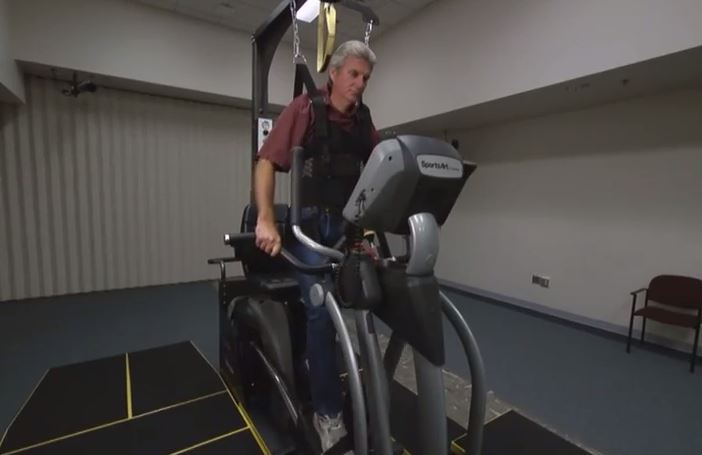BTN.com staff, October 30, 2014
Stroke victims trying to build their motor functions back up during recovery typically work with physical therapists on huge machines that combine the arm exercise capabilities of an elliptical with the slow-moving function of a treadmill, all while being held upright by a harness attached to the ceiling or some other overhead structure.
The machines work, but they require a lot of money and space. To create something that was smaller and cheaper, University of Nebraska mechanical and materials engineering associate professor Carl Nelson worked with Dr. Judith Burnfield and her team at the Madonna Rehabilitation Hospital in Lincoln, Neb.
The team of researchers, along with students from the University of Nebraska, invented ICARE, which stands for Intelligently Controlled Assistive Rehabilitation Elliptical. (A grant from the National Institute on Disability and Rehabilitation Research supported the work done by the students.) It?s an electronically-modified elliptical machine that?s more accessible to patients from both a physical and an economic standpoint.
?People who need this [rehab] are having trouble accessing the appropriate therapies because they have to be in a clinic with a physical therapist or because their condition makes it hard to get up onto the equipment,? Nelson said. ?Those are the obstacles we tried to solve.?
The name itself was the result of a collaborative effort led by Nelson, who had some experience titling new devices.
?We knew some of the key words we wanted to include,? Nelson said. ?We were throwing around acronyms, and we took the first letters of the words we wanted to use and did sort of a Scrabble approach. But we came up with a good name, and it?s not a stupid acronym. It actually sounds good.?
The ICARE is, as Nelson said, more or less a retrofitted elliptical machine that has ?some additional features? built around and into it. For instance, the control panel at the front of the machine (which normally has heart rate and distance monitors) was modified so it can be converted from a normal elliptical into ?ICARE mode.?
There are additional motors and pulleys to drive the machine when it?s in assisted-care mode, a bodyweight-support system, and a ramp on one side and a small stairway on the other (with handrails) to make it more accessible to patients. There is also a seat behind the elliptical, supported by the frame for the harness, to allow for resting.
?We wanted to take the existing elliptical technology off the shelf and motorize it, adding intelligence to it so that it can be used as a rehabilitation tool as opposed to just an exercise tool,? Nelson said. ?With the additional ramps and stairway and body support, it is a little larger than a standard elliptical, but it is far less expensive than the standard equipment used in hospitals for rehabilitation.?
The ICARE also has integrated sensors that detect the level of assistance needed by the individual based on their walking gait. The motor reacts to provide the necessary level of support related to body weight and stability. Safety straps hold the walker?s foot in place while the automated elliptical propels the patient in a walking motion.
The first ICARE prototypes were developed in 2007, but work continued on these devices for a few more years. In 2011, the machine was a finalist in the International Da Vinci Awards for innovative design. While Nelson noted that much of the development work for ICARE was done by Dr. Burnfield?s team, he added that his students contributed greatly to key elements of the final version.
?We had students who worked on mechanical design, designing parts for the machine,? Nelson said. ?The hardware fabrication was done with students driving that. The motor mounts, pulleys [and] all the custom components that go into turning a passive elliptical into a power device were done by students.?







